
English
This is the first of two posts that I will publish about the excursion that I organized with my family last Saturday to the town of Taramundi (Asturias-Spain).
I hope you are having a great start of the week #Hive and #Pinmapple friends.
During the last fortnight of August I am on vacation and because I am traveling all year round for work reasons I usually take the opportunity to stay at home resting and organize only small trips to towns where I can move and return to sleep at home during the day.
Last Saturday, I went to the village of Taramundi (Asturias-Spain) with my mother, my uncles and a 7 year old cousin of mine. Taramundi is a small village with 700 inhabitants that is located in the Asturian mountain that separates Asturias from Galicia. In turn, since the 80's it was the driving force of rural tourism in Spain and currently has many rural hotels, campsites, museums such as the museum of the cutlery or the museum of the mills of Mazonovo among others.
To get to Taramundi from my house in Arboces (Asturias) the journey takes 45 minutes by car. For the outward journey, due to the fact that in Vegadeo I took a wrong detour, the total time was 55 minutes. Therefore, for those who want to get from Vegadeo to Taramundi in a faster way, I recommend to take the AS-21 road with a distance of 18 kilometers. The other alternative route from Vegadeo, but which is longer, is to take the N-640 road to Puentenuevo and from there take the LU-704 regional road. As I finally did one way on the outward journey and the other on the return, I can tell you that both roads are very well paved, making the trip easier.
Because in Taramundi there are several museums to visit and points of interest, the previous days we organized the places and museums we wanted to go. Throughout this post I will be presenting the points of interest and museums that we visited throughout Saturday in this beautiful Asturian village.
After leaving home around 11:15h, we arrived in Taramundi after 12:00h. The first thing that strikes the attention of this town is how well preserved it is and the spectacular scenery that surrounds it between valleys and mountains.
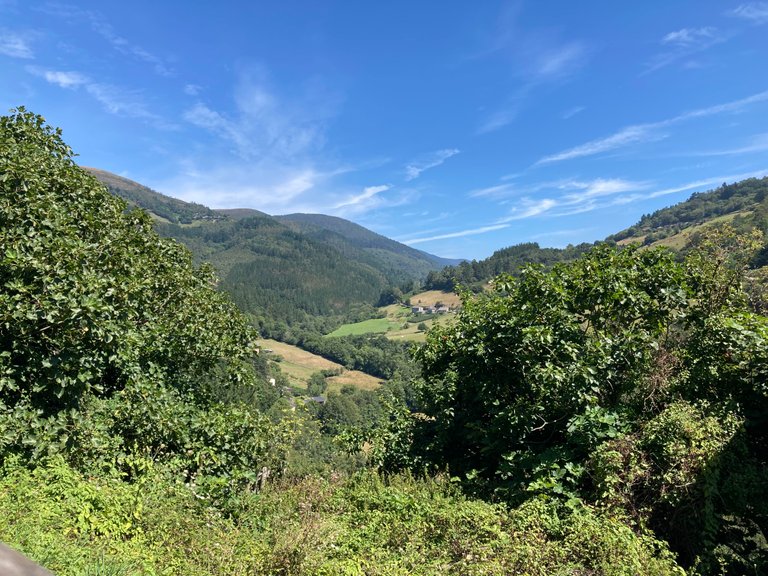
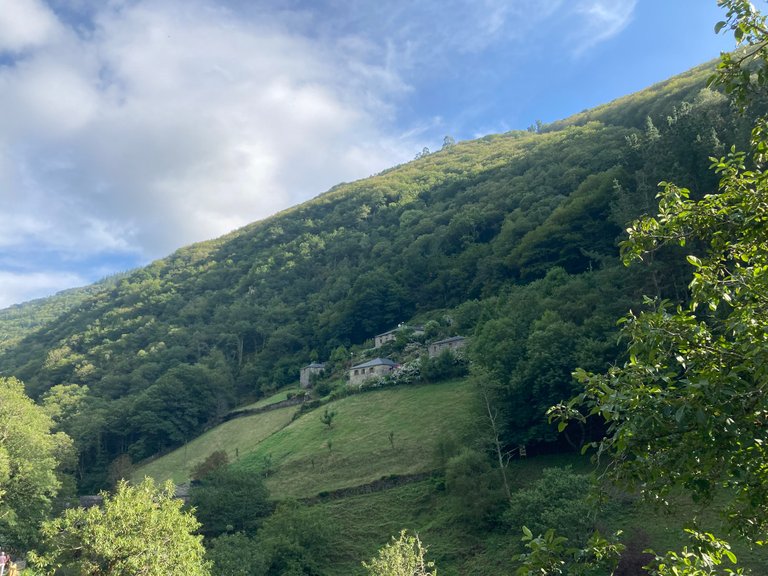
Museum of the Mills (Mazonovo)
The Museum of the Mills of Mazonovo about 100 meters from it, has a large parking lot, which in turn serves as a viewpoint to partially see part of the museum and the water mills that are inside.
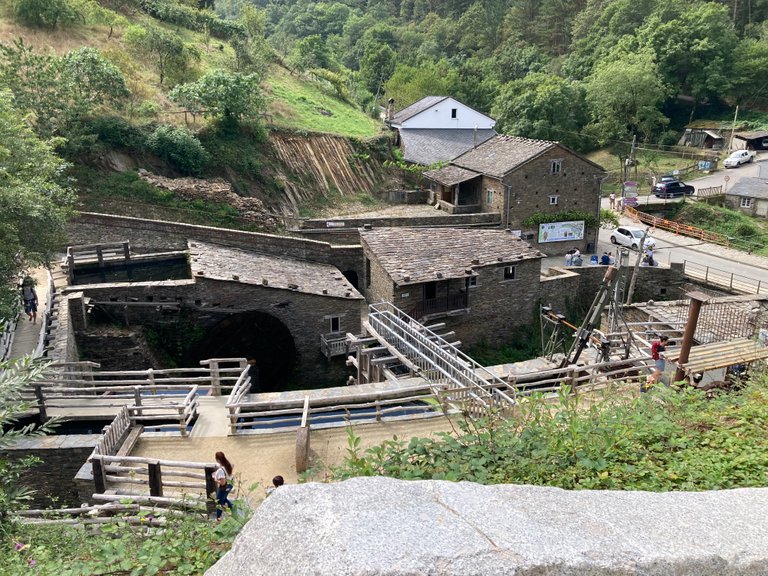
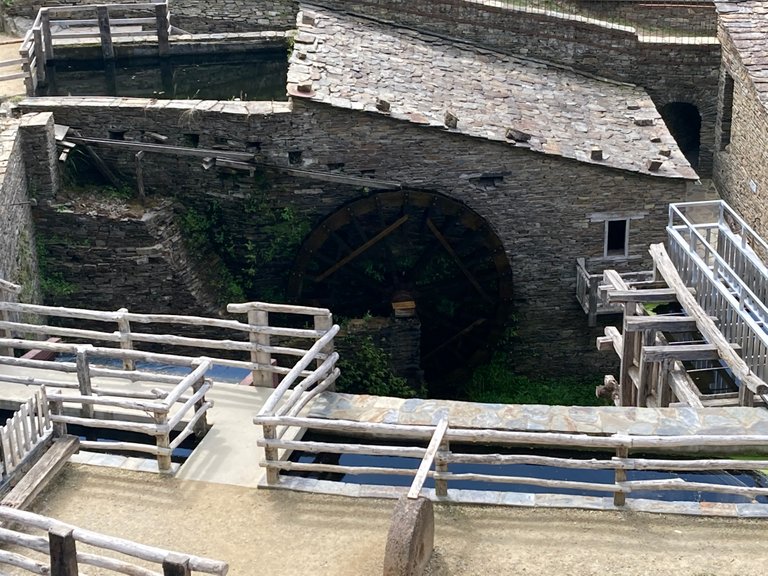
At the entrance of the museum, one can already enjoy the museum itself seeing the millstones that decorate part of the exterior, seeing the aqueduct of the museum or simply watching the riverbed that drives several of the mechanisms of the various watermills inside.
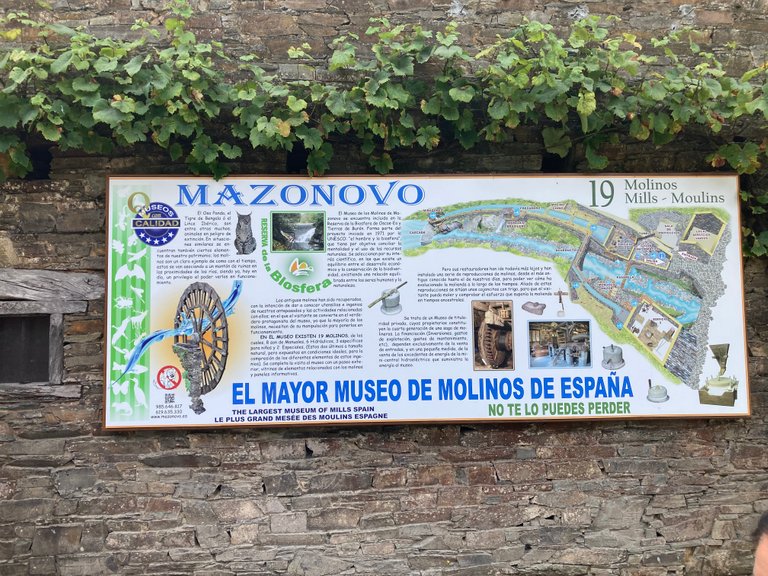

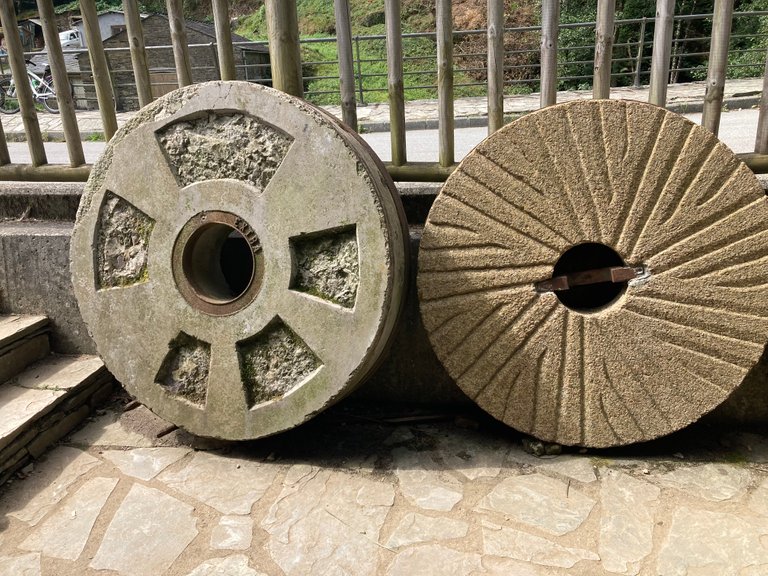
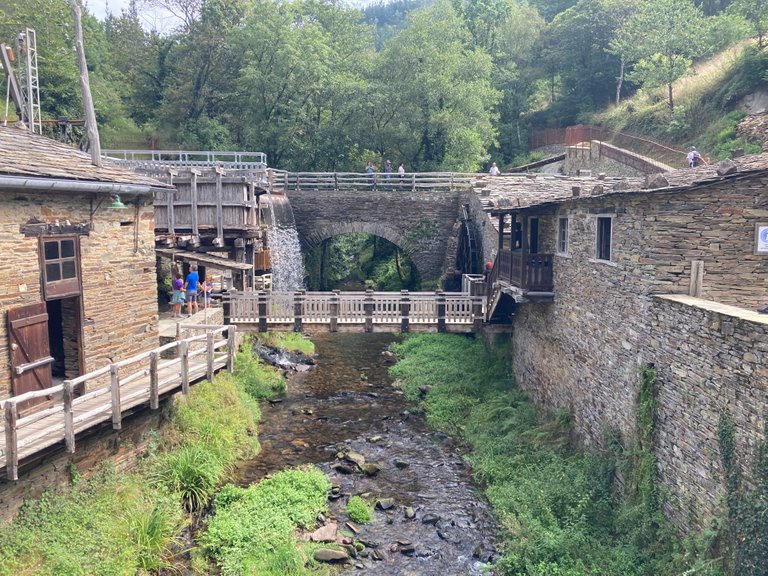
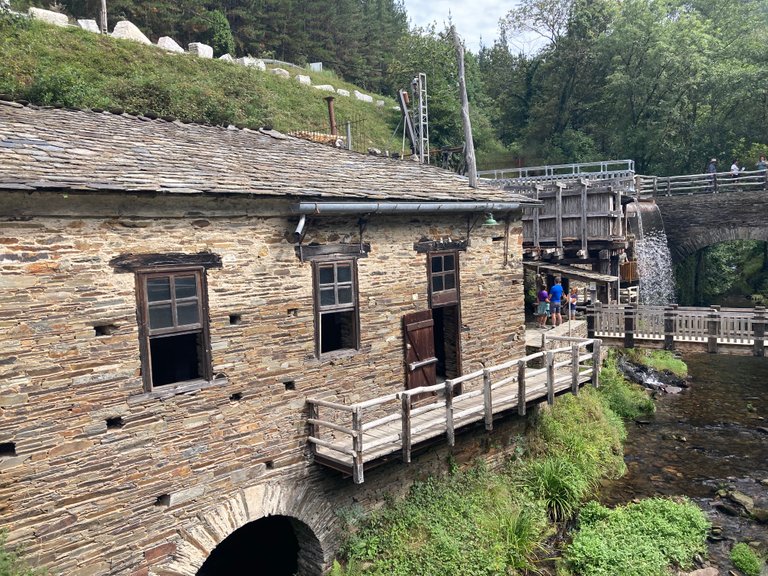
Since there were not many people at that time, we only had to wait 10 minutes after the purchase of the ticket to take a tour of the museum. With the purchase of the ticket we were provided with a complete guide to the museum and the different types of watermills (Asian, Brazilian, Spanish, etc.) and also information about much older manual mills.
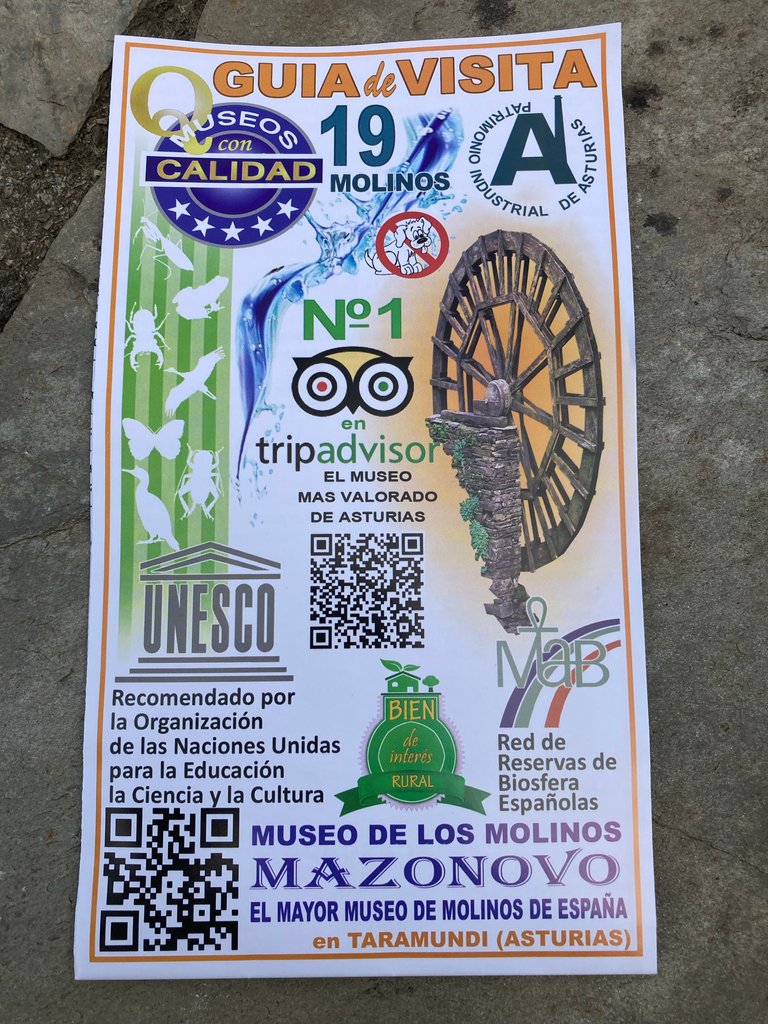
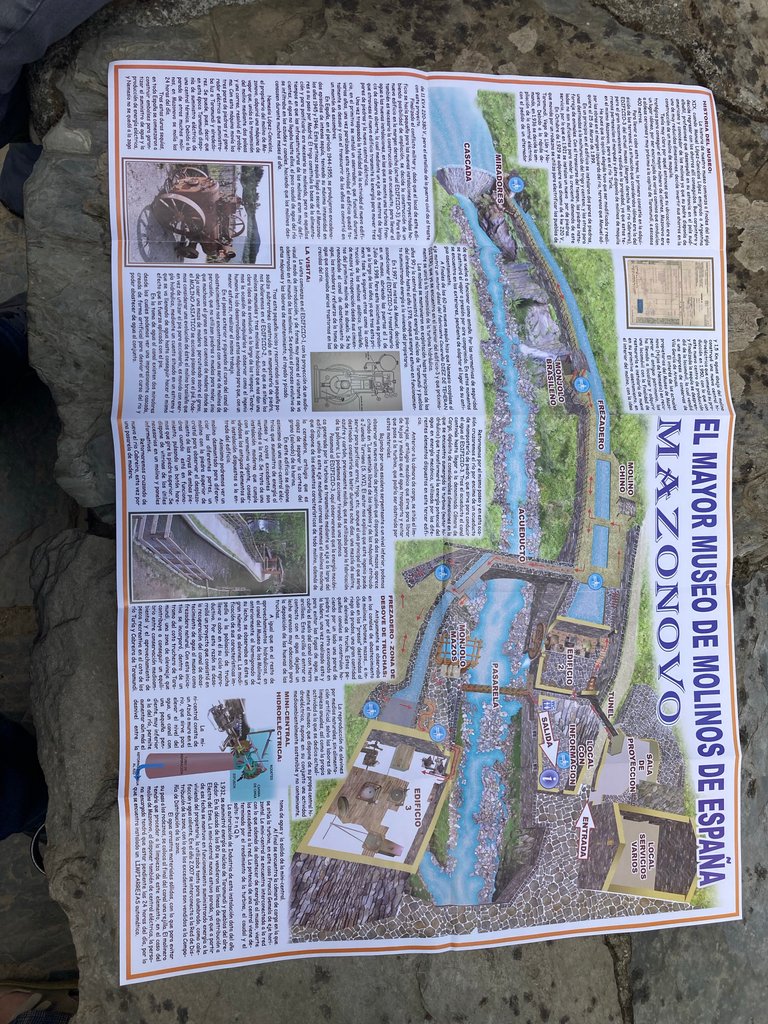
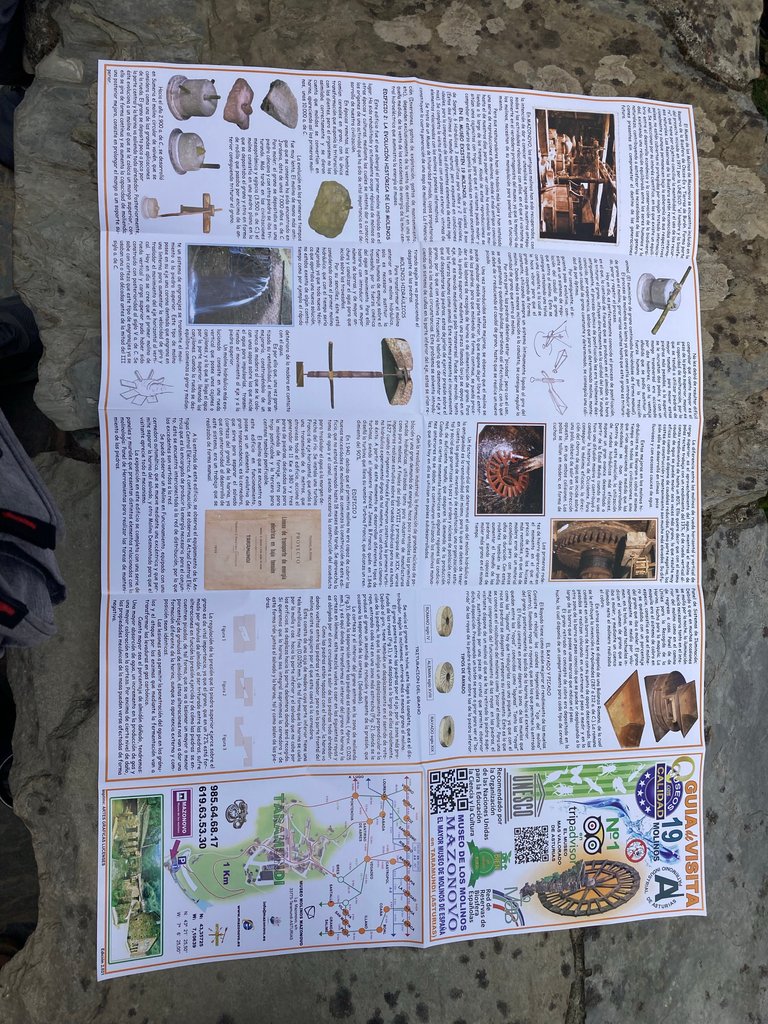
For groups where there is a small child, they also provide a small paper bag where one can collect the flour he/she has milled in one of the instances of the museum and also a small test with the mission that this child can obtain his/her miller's diploma.
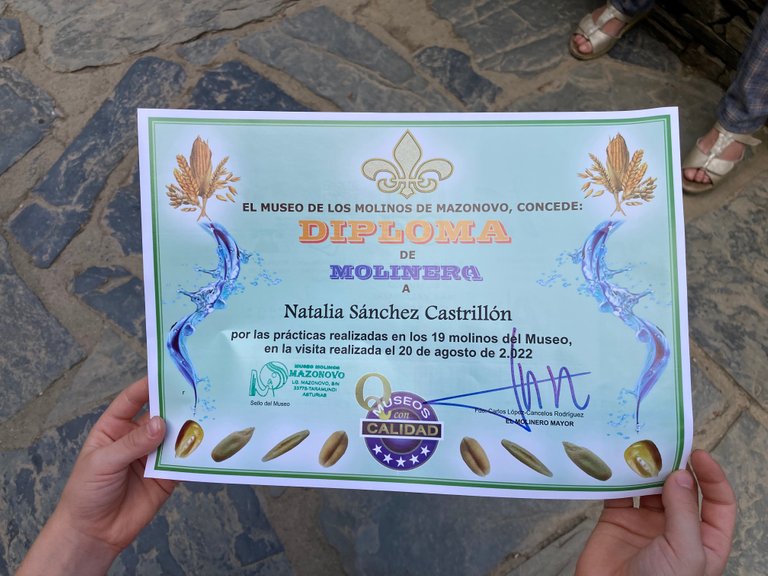
Once inside the museum, the visit begins with a small introductory video of about 5 minutes where we are told the evolution since the ingestion of grain cereals, the need for grinding to obtain flour to make it more assimilable by humans and the evolution that mills have undergone since its inception where it consisted of grinding the grain between two stones to the evolution and the use of water power to grind the grains.
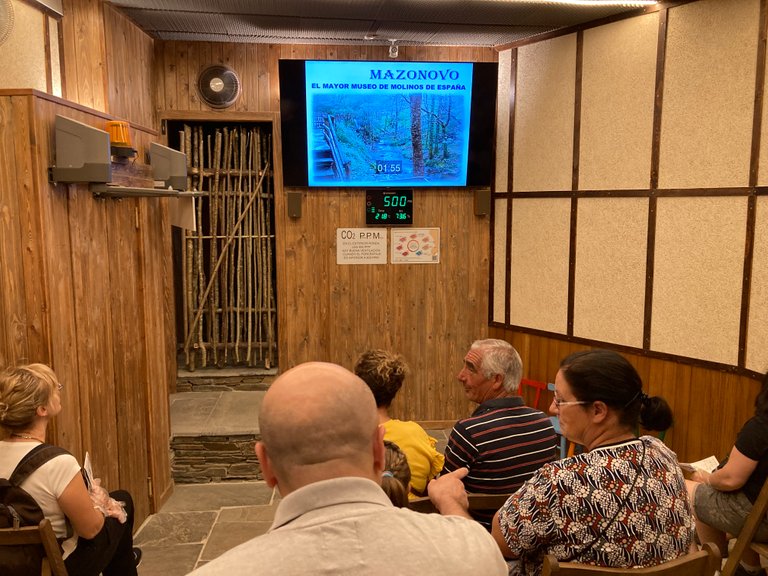
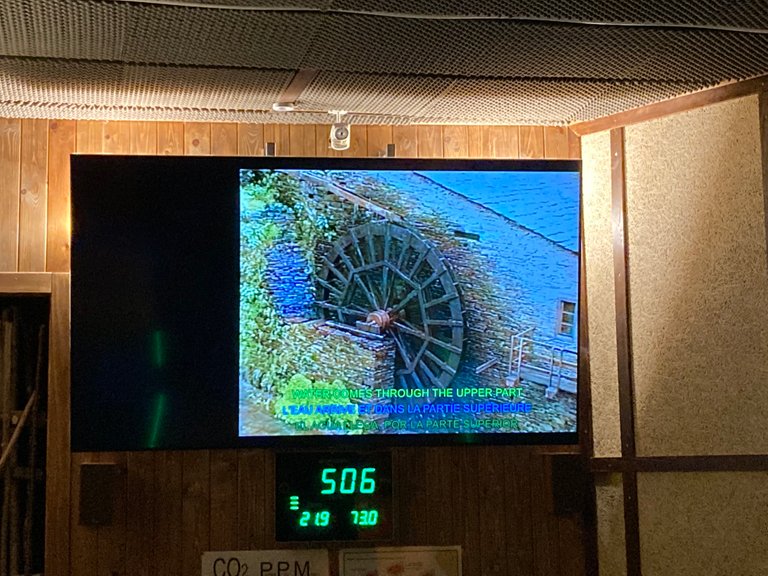
After this introductory video, the visit to the different types of mills begins in a room that is accessed from the projection room through a subway passage.
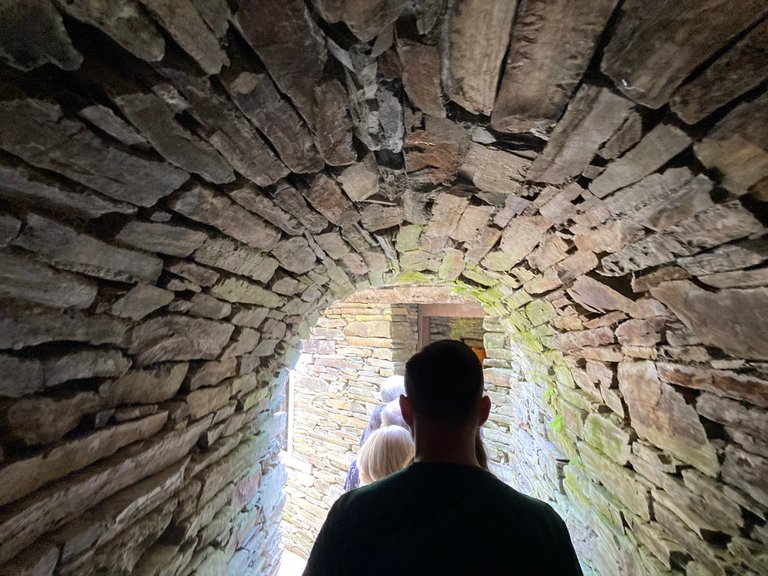
Once we reached the room, we found different manual mills and three hydraulic mills that give us an idea of their evolution over time. In this room, we were given the option to manipulate both manual and hydraulic mills through different levers that allow the water to impact on certain mechanisms that rotate the millstones to grind the grain. Thus, in this room we got an idea of how human ingenuity developed these machines so that, with less effort, they could do the same work.
Manual mills

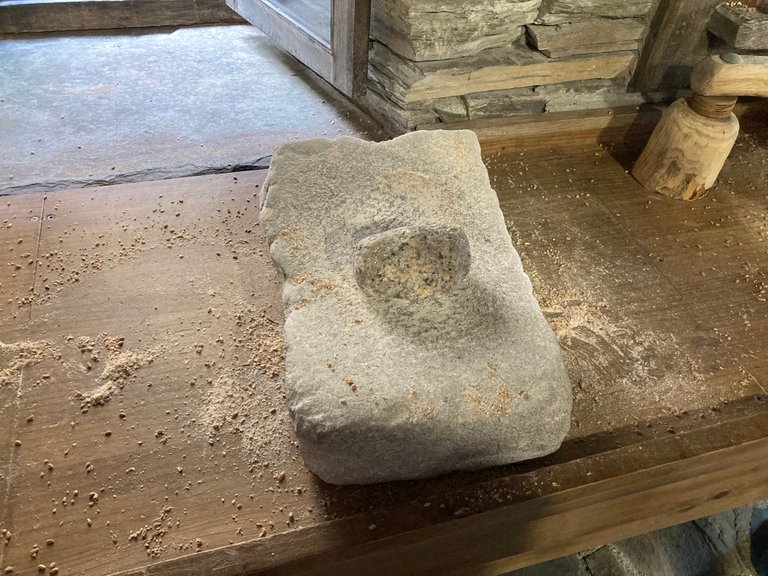
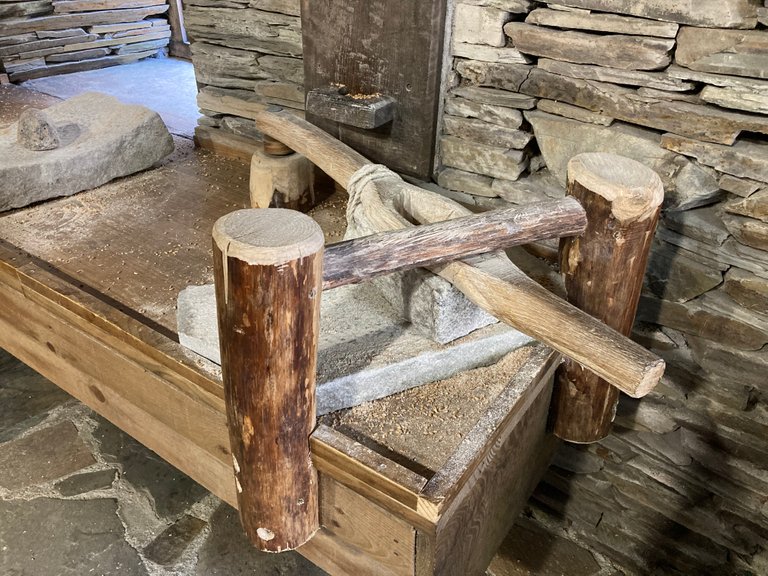

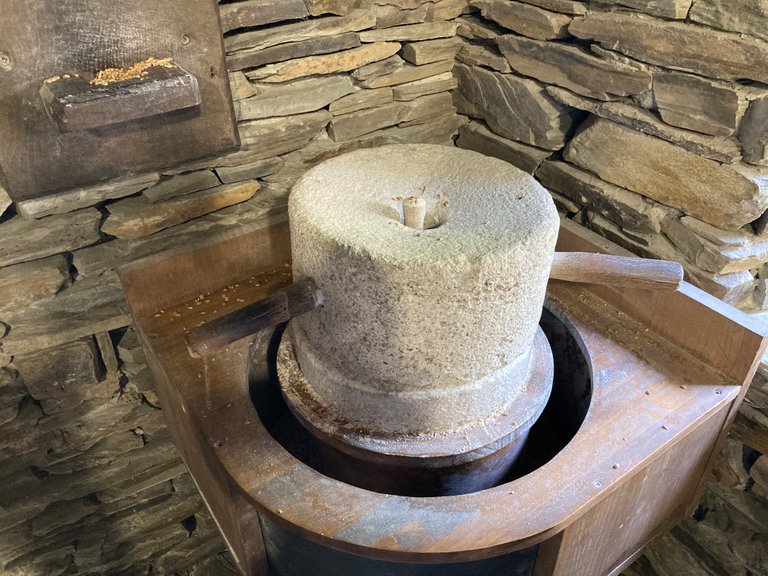

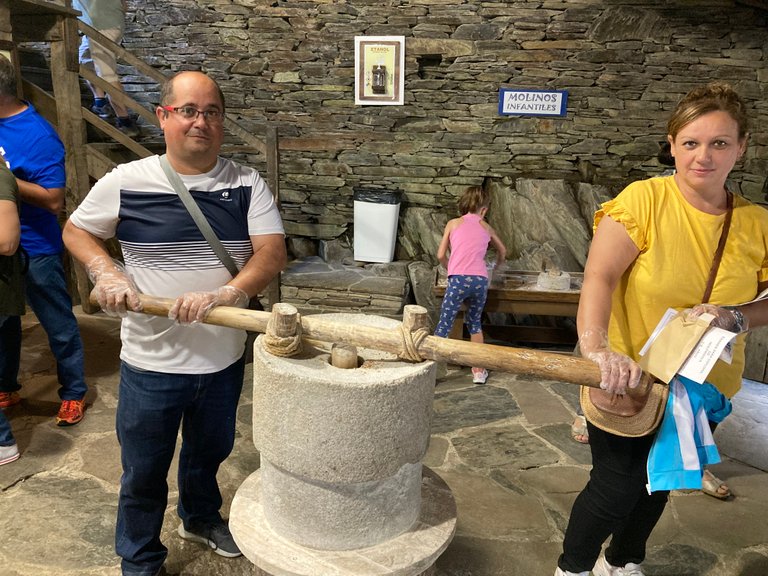
Hydraulic mills
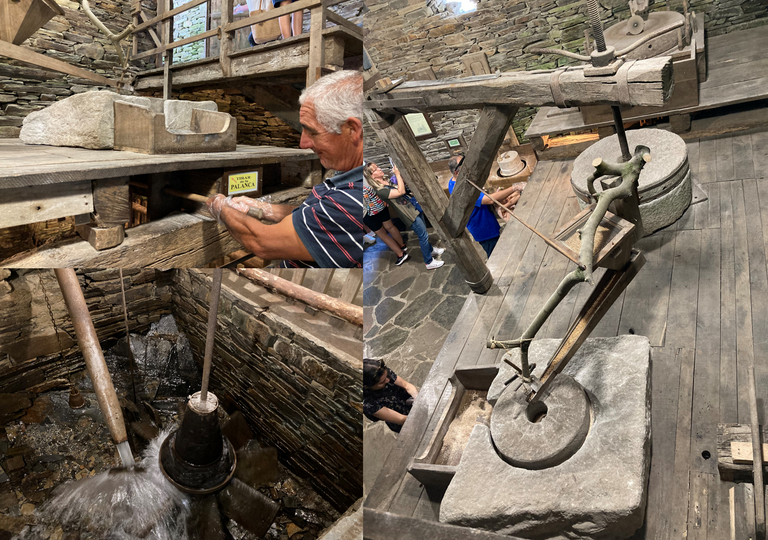
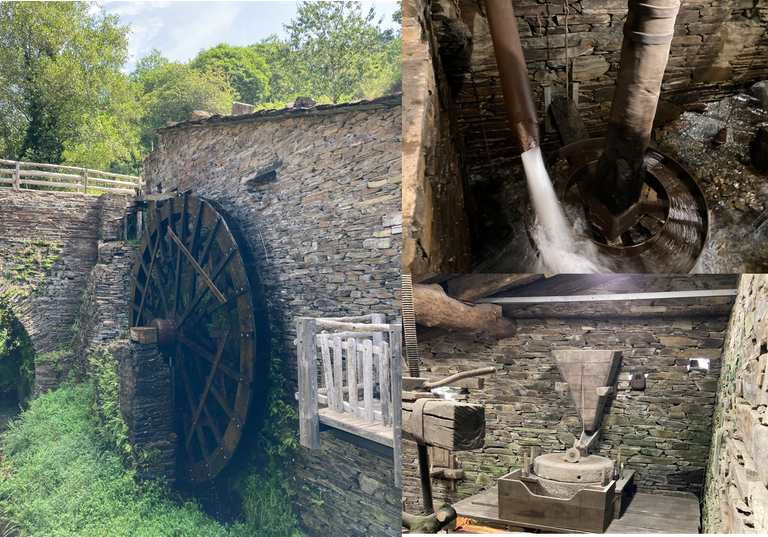
After leaving this room, we will find ourselves in the outdoor area where there are a series of water channels. In this outdoor area we find a beautiful and very well ornamented environment. I was struck by the large decorative trunk that included its root that serves as a division for the beginning of the visit outside the museum.

Percusion Mills
In this outdoor area we found two percussion mills that, unlike the previous mills, crush the grain by the impact of a mallet on a bowl of wood and stone. The first one we find is the Chinese or Asian mill, which consists of operating a lever with the foot with a central point of support, so that when the mallet is dropped it causes the grain to be crushed. At this point, as I had the whole family together looking at the mill, I asked them to come closer so I could take a picture.
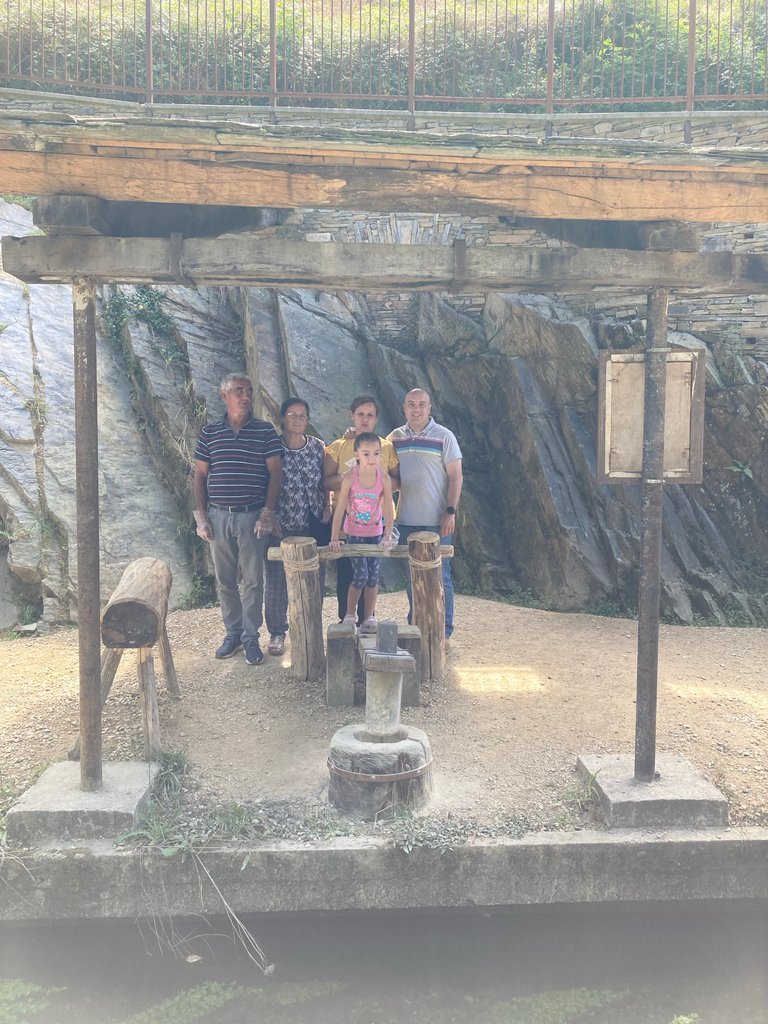
Continuing the walk next to the canals, we found an evolution of the Asian mill, the Brazilian mill. This resembles the Chinese mill in the mechanism of grinding the cereal, but uses hydraulic energy through the filling of a container with water, causes the rise of the hammer and when the water is spilled causes the sudden fall of the hammer on the container where the grain is to cause grinding.
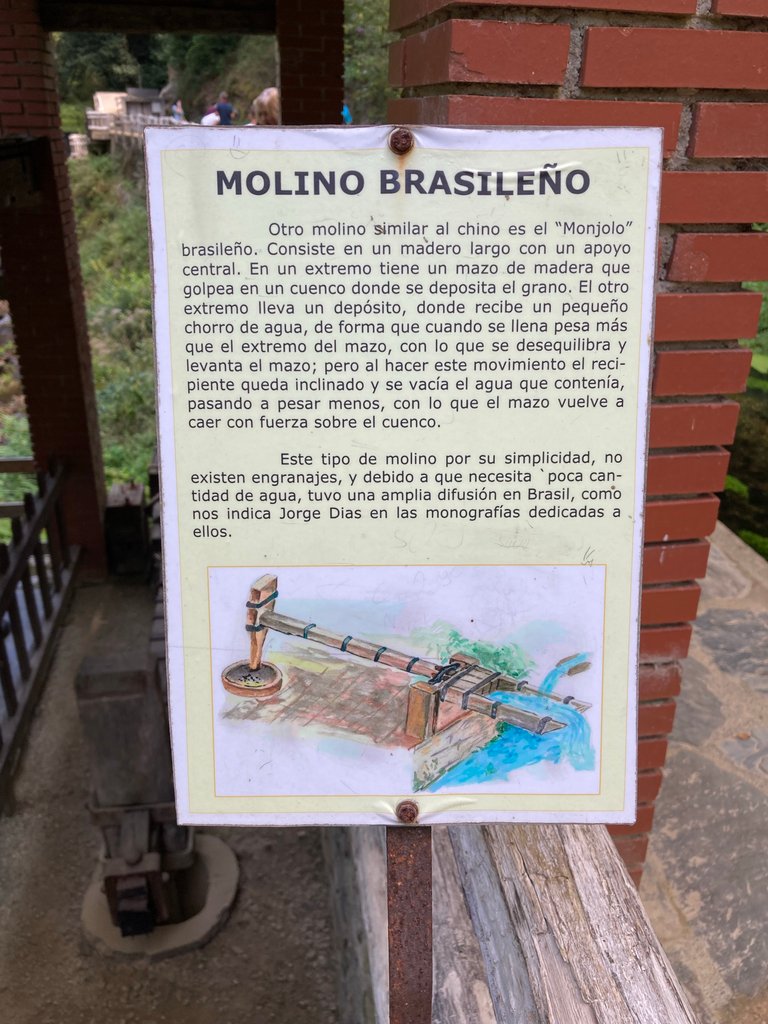
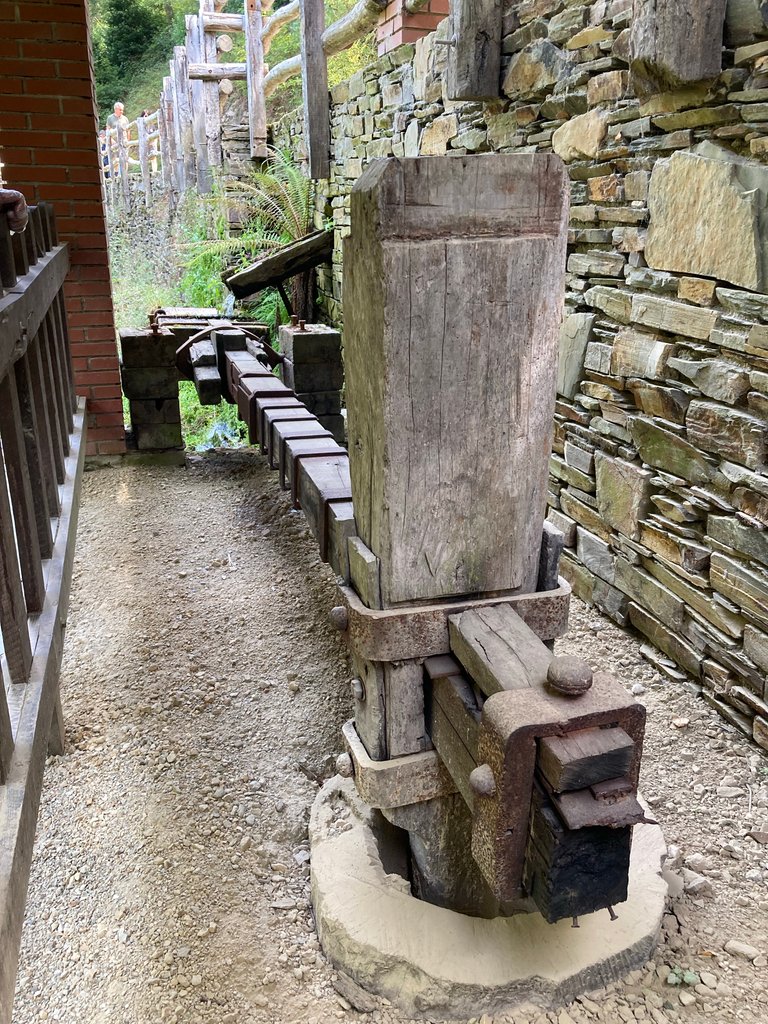
Viewpoints and waterfall
Continuing along the path, we find the water intake of the canals where there are two viewpoints from which we can see an impressive artificial waterfall and a small water reservoir where one can see the vegetation entering the river.
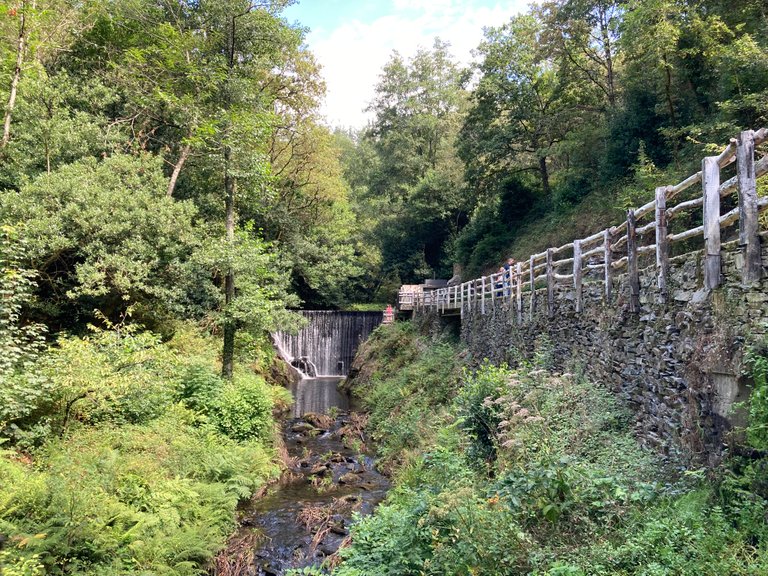
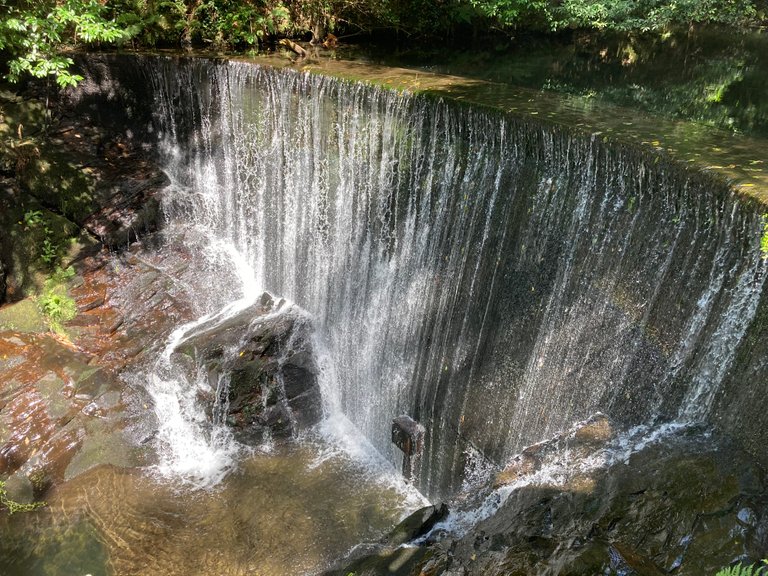
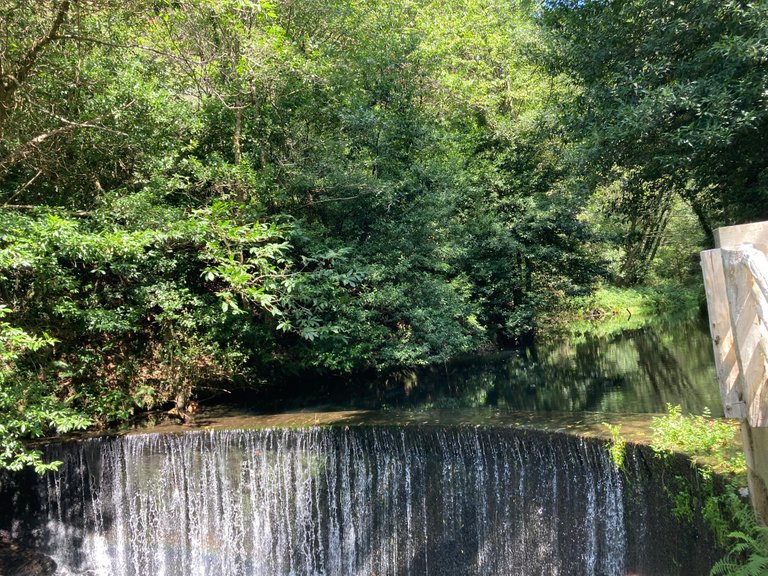
Return, views from the aqueduct and from under a waterfall
We return along the same walk until we pass the Chinese mill and pass through an aqueduct that serves to conduct water to the last part of the museum. After the aqueduct, the channel continues to reach a large tank where a turbine is submerged to transform the potential energy of water into mechanical energy, used by the various elements arranged in the last part of the museum and that at its exit forms one of the waterfalls of the museum that we could see from outside it. In this place I took the opportunity to take a picture very close to the waterfall and see a curious effect of the water as it descends.


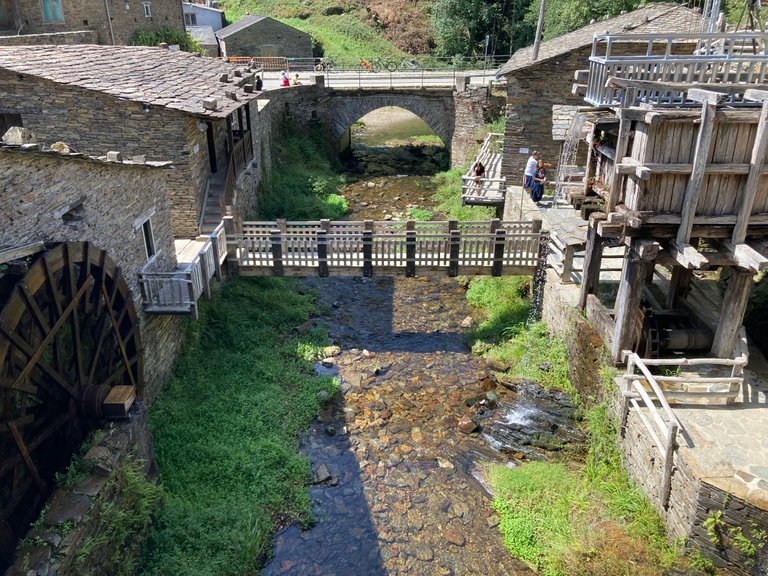
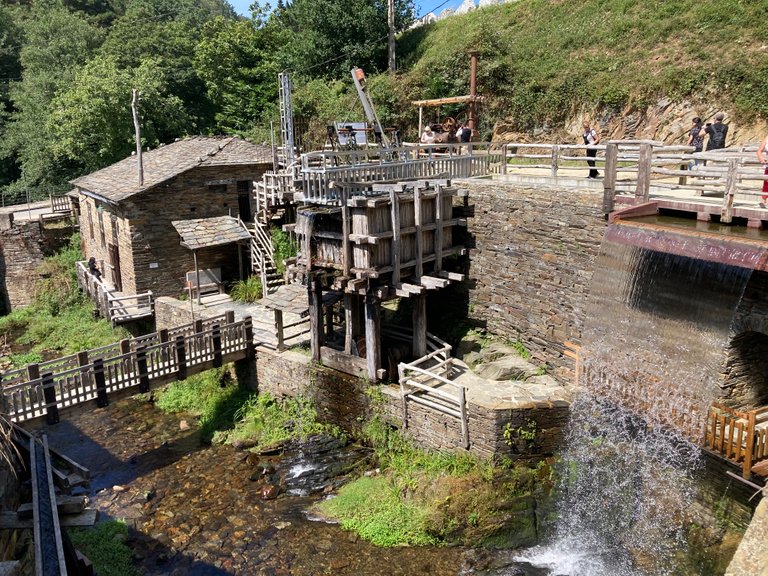
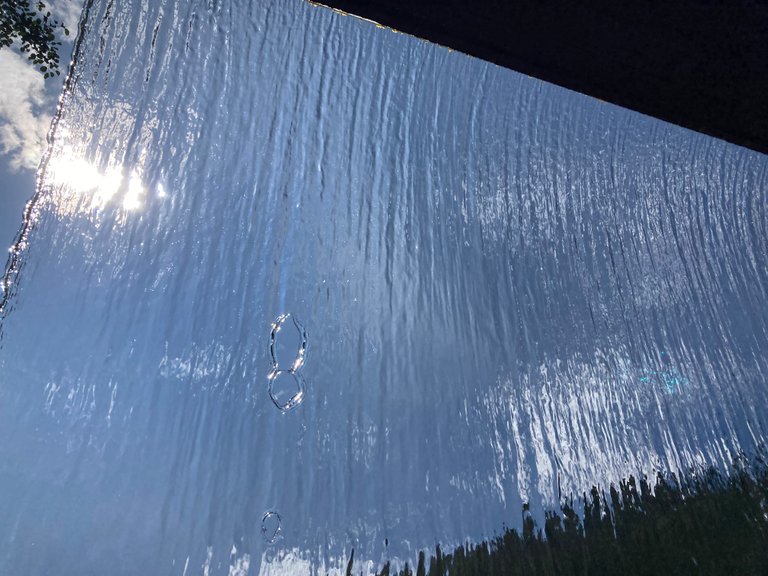
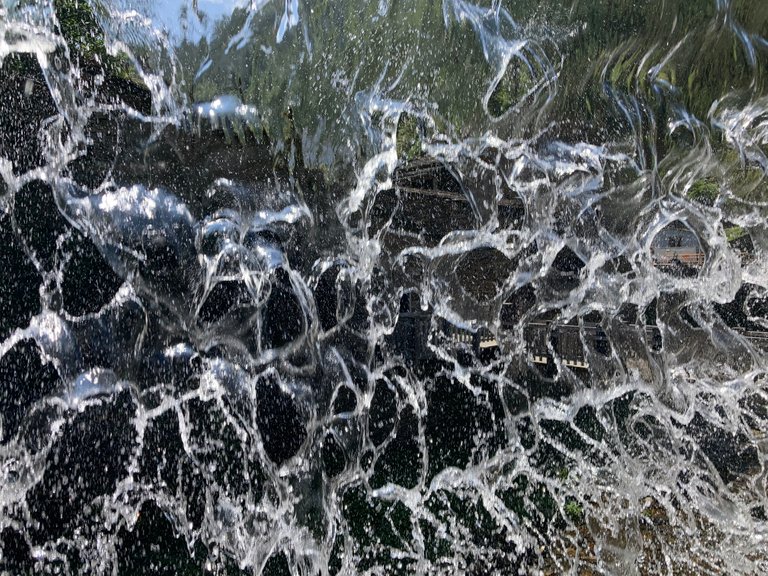
Locomotive as an alternative to hydropower
At the top, once crossed the aqueduct, there is an esplanade where it is striking that there is a steam locomotive. According to the information provided to us in the guidebook, in times of drought, where there is not a large flow of water in the 40's, it was an alternative to the potential energy of water to drive the steam energy from the boiler of the locomotive to supply electricity to the mini electric station that powered the electric mill.
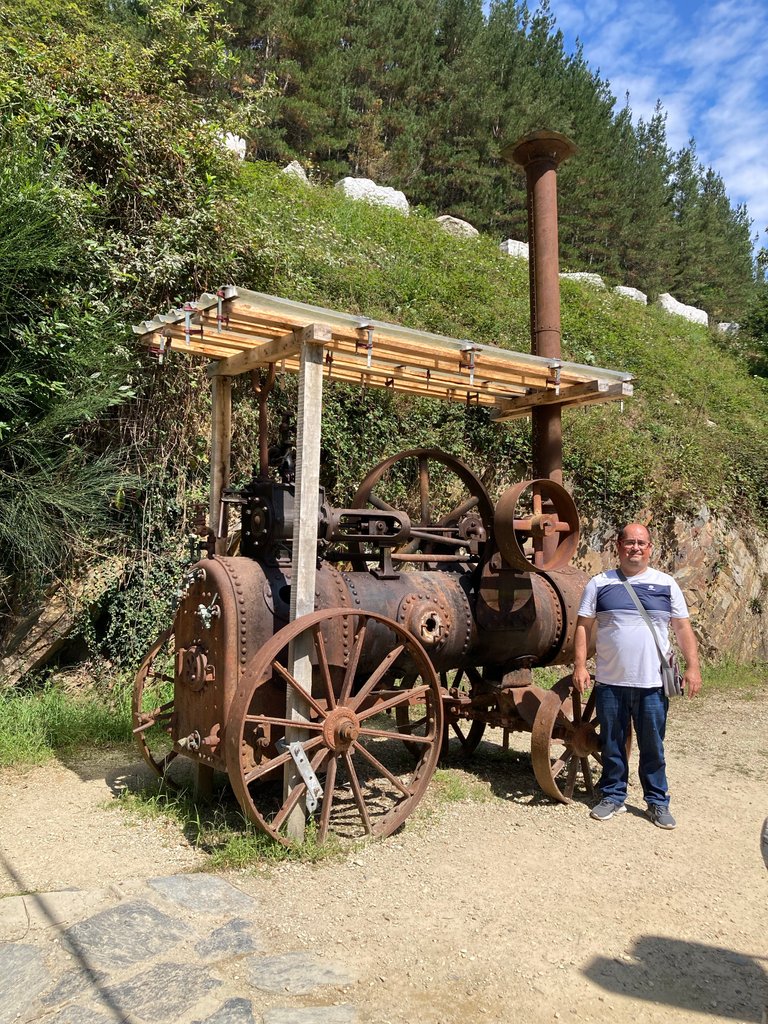
Other Percusion mills
Through some stairs that were near the locomotive we were able to go down to the lower floor and see the last two hydraulic mills that like the Brazilian mill are percussion mills. One of them was operated through a lever that made water fall on a wheel and thus caused the movement of the mallets and the second of them through the filling of a container caused a mallet to rise in height and when the water was spilled the mallet fell with speed and crushed the grain.
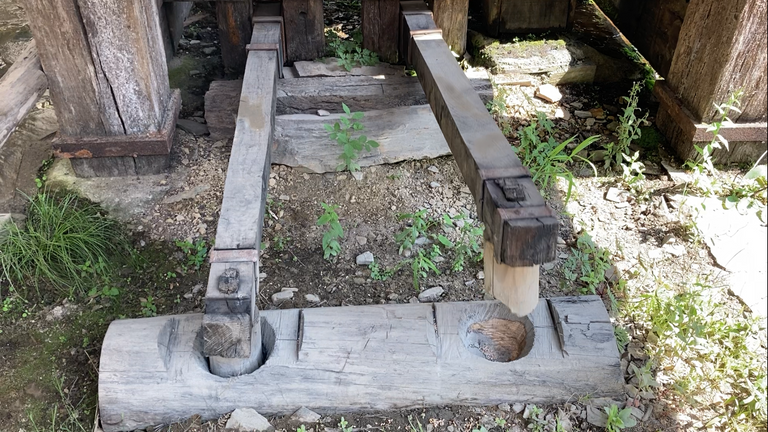
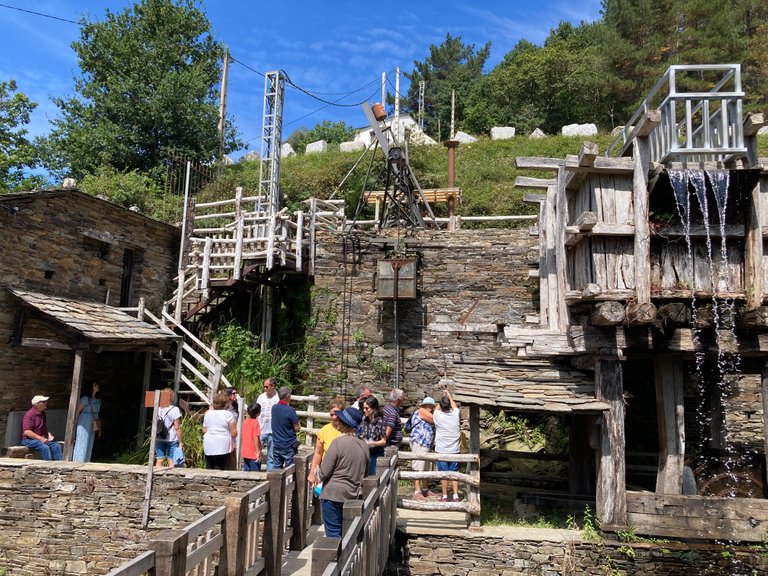
Mill powered electrically by hydraulic energy
In the last part of the museum we will observe that the mechanical energy generated by the turbine near the waterfall is transmitted by means of an axis along the building, connected to this axis by belts we have the modern mill that has the characteristic elements of the mills.

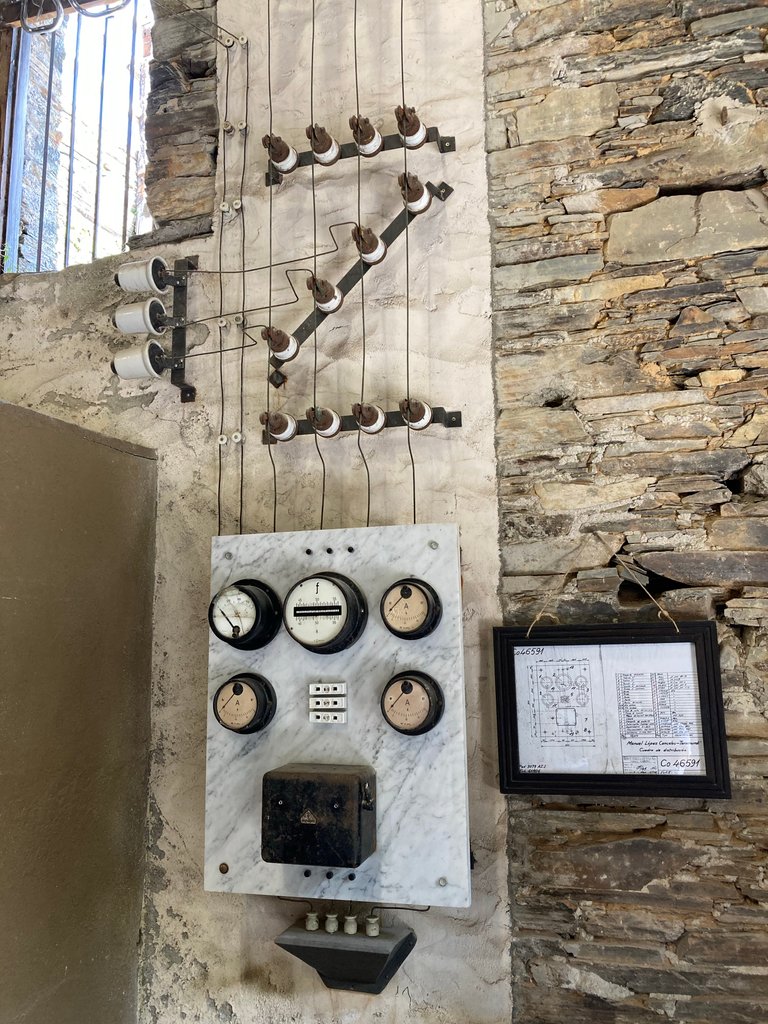
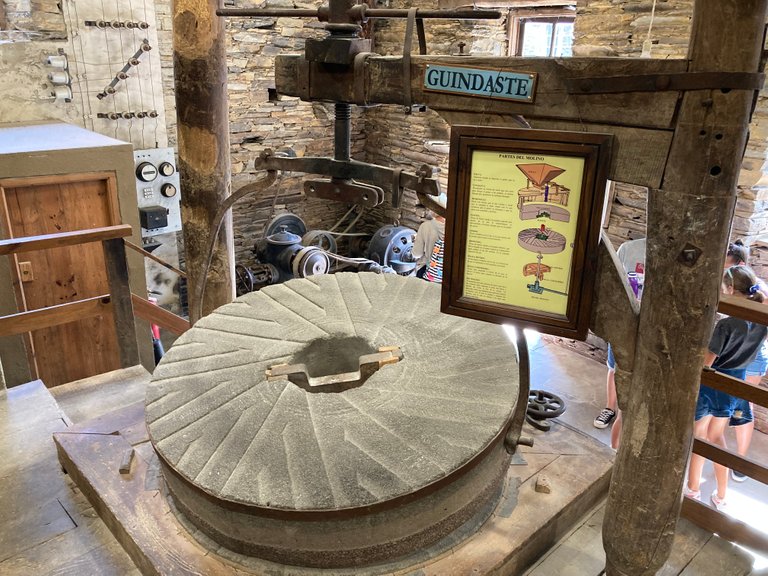
We will also be able to see a disassembled mill to differentiate the different parts and different showcases with tools and utensils used in the mills.
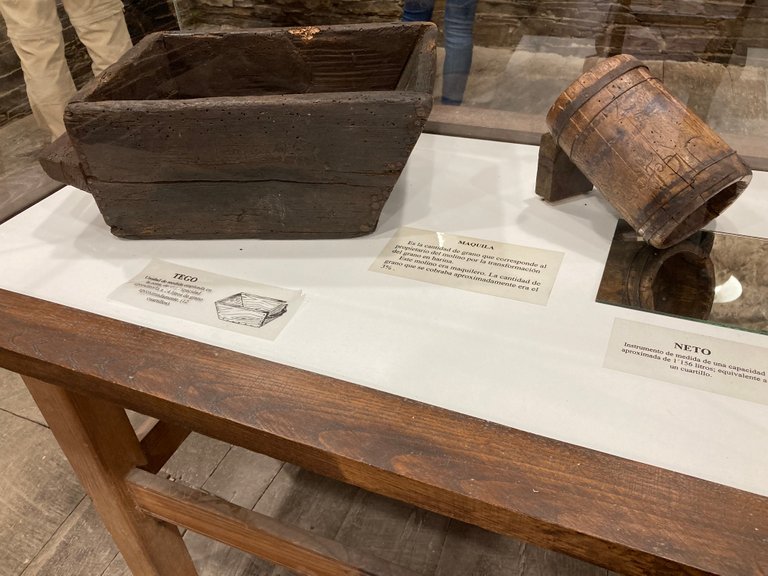
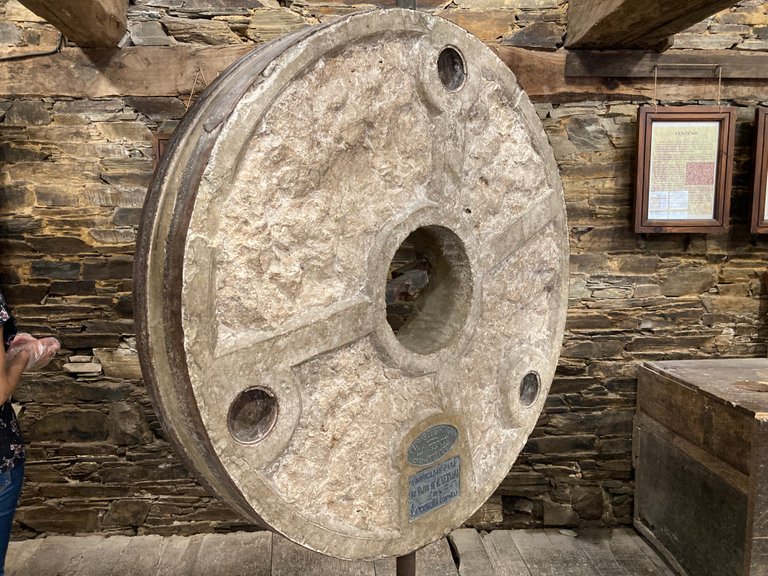
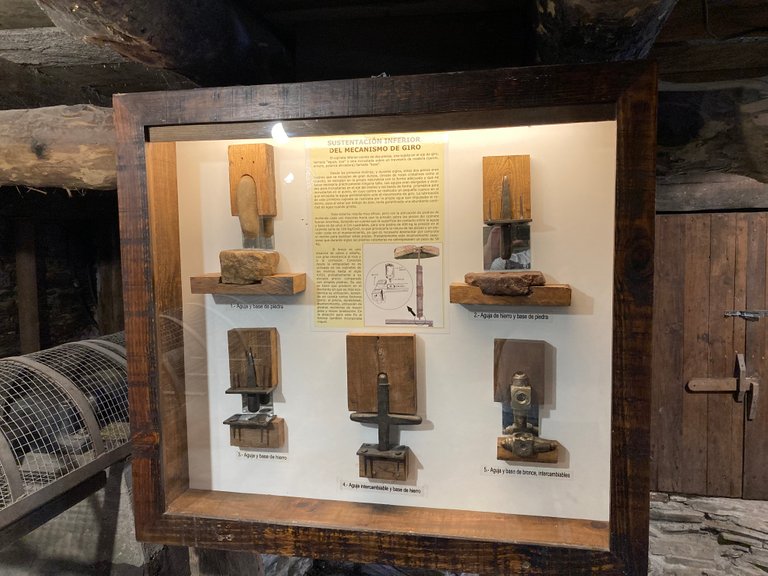
At the exit of the museum, we handed in my cousin's exam and she was able to obtain her miller's diploma.
Sidrería Solleiro Restaurant
After the visit to the mill museum, where we spent about an hour and a half, we set out to find a place to eat. To do this we walked about 400 meters up a steep slope with a 15-20% slope, so that we reached a road that led us to the Sidrería Solleiro where we asked if they had a table for lunch. Since it was already full, they took our order so that we could eat at the 15:00 shift.
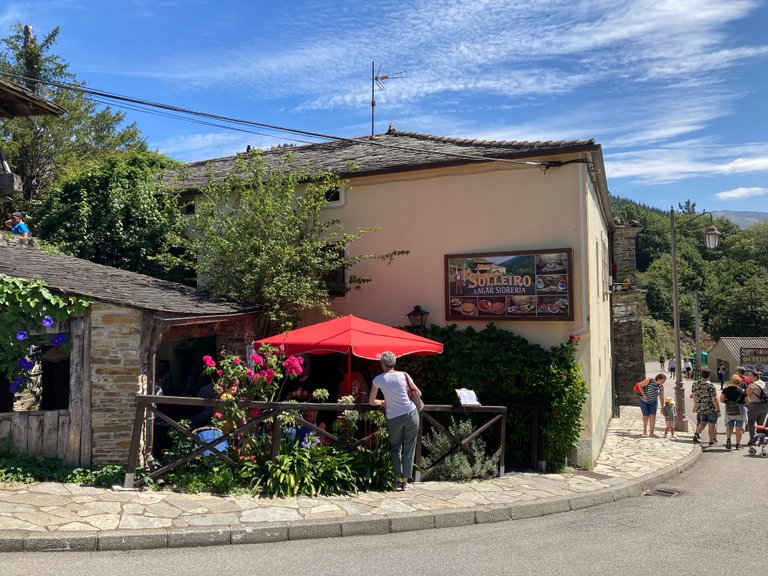
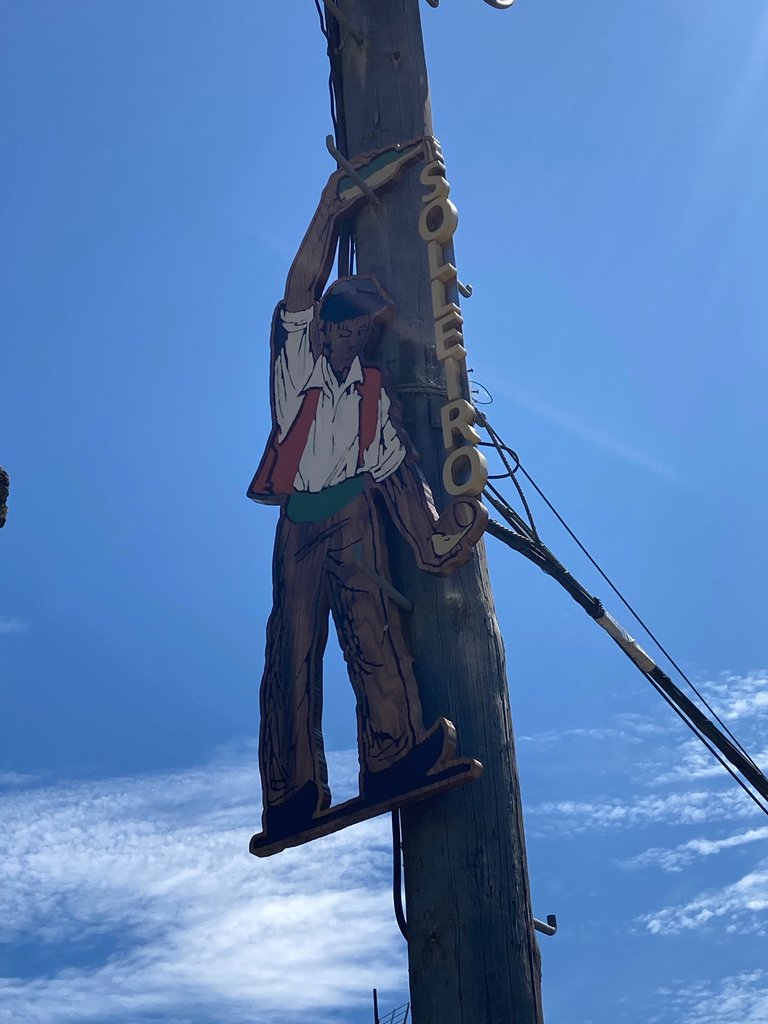
Urban center of Taramundi
Since we had to wait for about an hour and the town center of Taramundi is not very big, I went with one of my uncles to see the town center while the rest of the family rested in the bar of the restaurant. When leaving the restaurant, the first thing that caught my attention was that the outside of the restaurant was formed by a typical Asturian construction which is the hórreo. This construction was formerly used in the villages as a place to store food away from moisture and also to keep them away from rodents and other animals to be a construction high off the ground.

Continuing on my way, I found 50 meters from the restaurant the tourist office of Taramundi, but at that moment it was closed. However, I really liked the office for that trip to my childhood when I saw the office decorated with some Flintstones sculptures made with flower pots and strings.
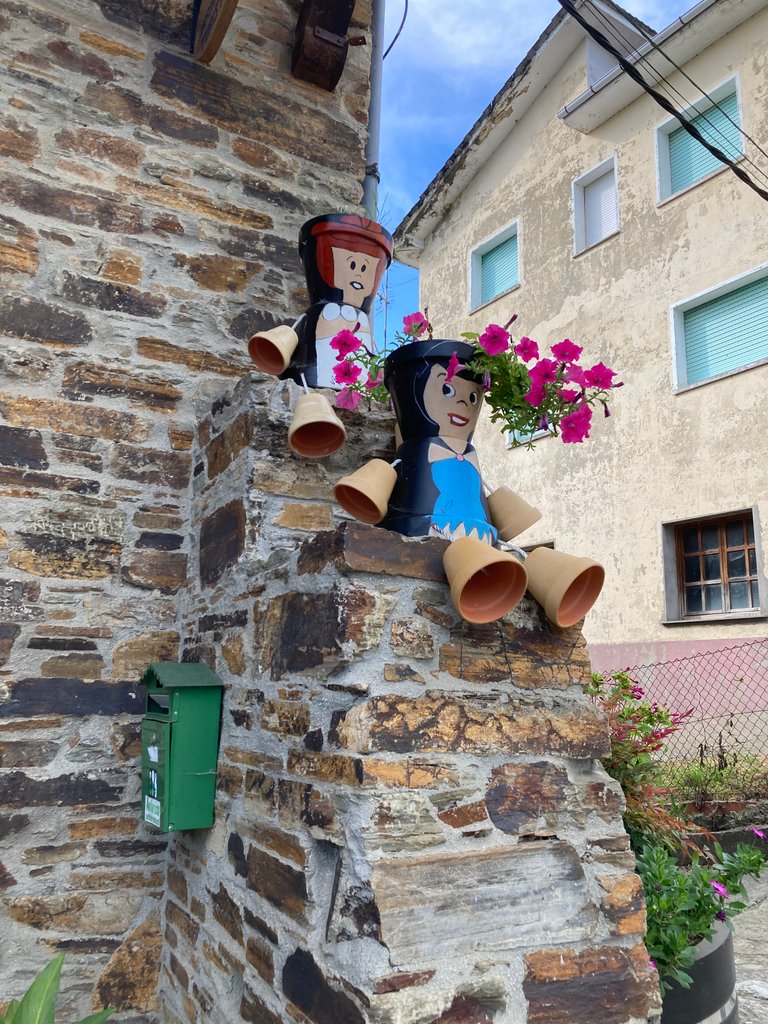
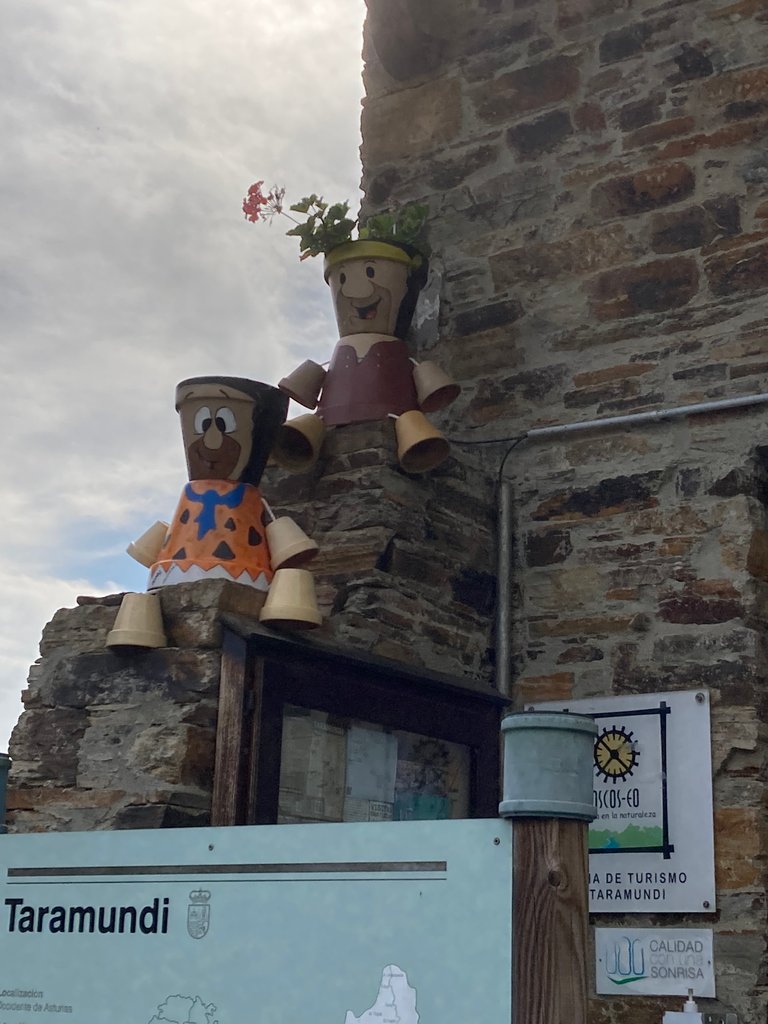
After passing by the tourist office, a steep slope took me to the urban center of the village where I was able to take some pictures of the beautiful village and its surroundings, highlighting the following points.
Centennial Oak Tree
In one of the traffic circles of the village, in front of the bakery and town hall of Taramundi, there is a sculpture made with a centenary oak of the XIV century.
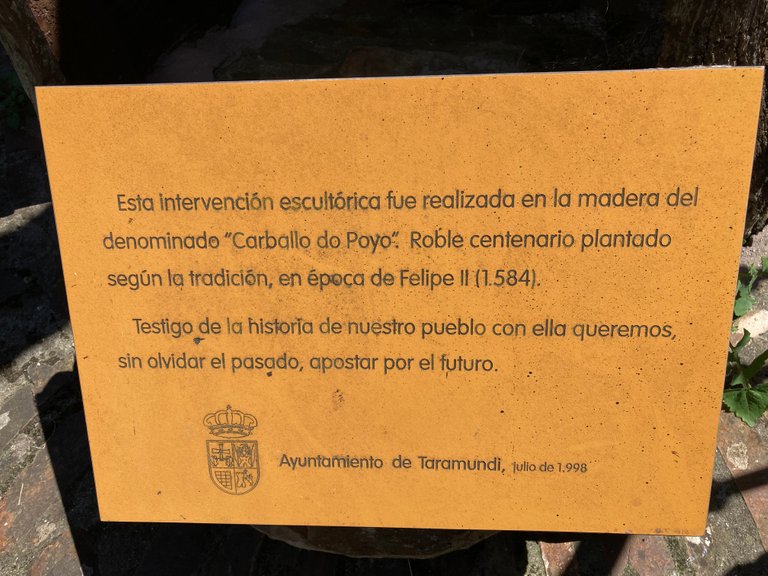
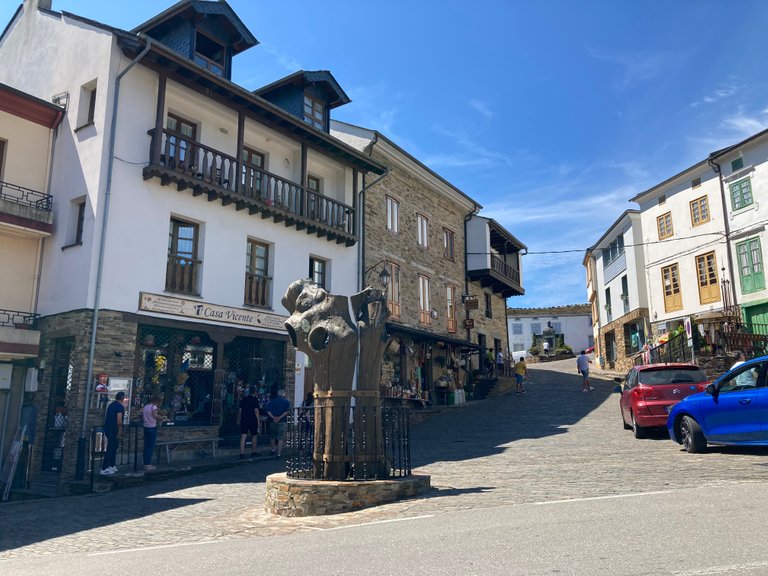
Monument to Manuel Lombardero Arruñada
50 meters from the sculpture of the centenary oak tree is another traffic circle with a sculpture in honor of Manuel Lombardero Arruñada, who was a teacher for many years in the village at the end of the 19th century.

Church of San Martín
Located next to the monument of Manuel Lombardero Arruñada, it is a beautiful church from 1714, it can be seen from almost any point of the village because it has a high tower.
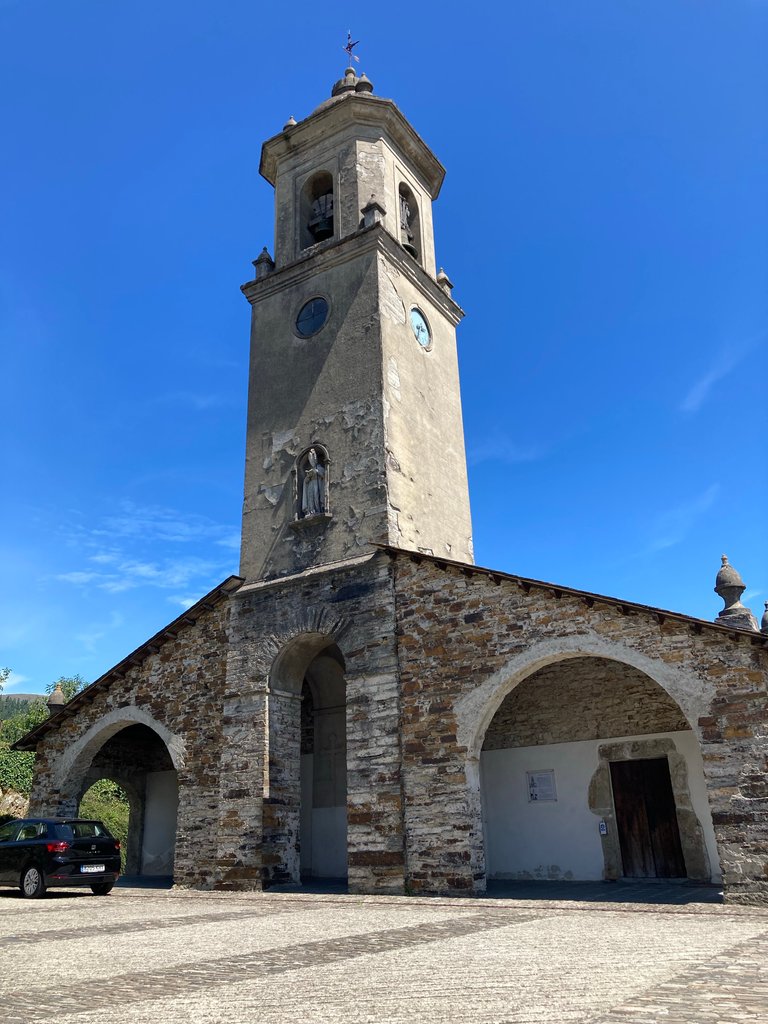
Town Hall and Bakery of Taramundi
The town hall building is one of the most beautiful in Taramundi. Completely covered in stone and at one of its ends is the bakery of Taramundi. Apart from the landscapes and museums, Taramundi is known in the surrounding area for its high quality bread. It could not be less, being a town with so much history, with the mills of cereal milling.

Once we had visited the town center, we returned to the restaurant because it was already the time we had been told to eat.
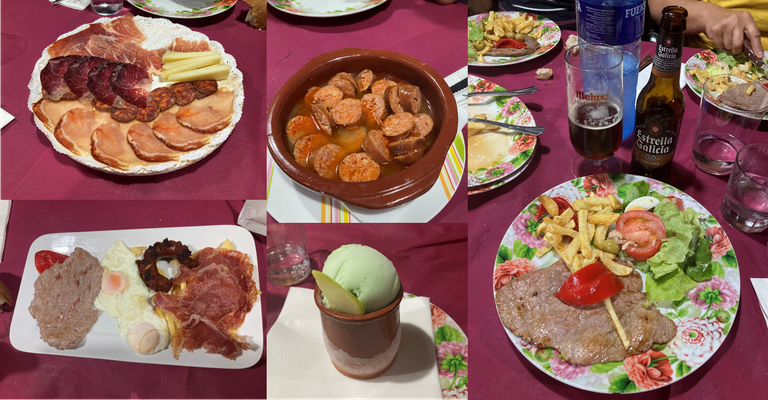
I send you a cordial greeting.
Pictures taken with my iPhone SE.
Cover made with Microsoft Powerpoint.
Translated with www.DeepL.com/Translator (free version).
The second part of my visit to the village of Taramundi where I will write about the museum of the cutlery, the castros and the ethnographic complex Os Teixois will be published in the next days.
Español
Esta es el primer post de los dos que voy a publicar relatando la excursión que organicé con mi familia el pasado sábado a la localidad de Taramundi (Asturias-España)
Espero que estén pasando un buen inicio de semana amigos de #Hive y #Pinmapple.
Durante la última quincena de agosto me encuentro de vacaciones y debido a que durante todo el año estoy viajando por motivos laborales suelo aprovechar para quedarme en casa descansando y organizar únicamente pequeños viajes a pueblos donde pueda desplazarme y volver en el día a dormir a mi casa.
El pasado sábado, me desplace al pueblo de Taramundi (Asturias-España) junto a mi madre, mis tíos y una prima mía de 7 años de edad. Taramundi, es un pequeño pueblo con 700 habitantes que se encuentra entra en la montaña asturiana que separa Asturias de Galicia. A su vez, desde los años 80 fue la localidad impulsora del turismo rural en España y en la actualidad cuenta con múltiples hoteles rurales, campings, museos como el de la cuchillería o el museo de los molinos de Mazonovo entre otros.
Para llegar a Taramundi desde mi casa en Arboces (Asturias) el trayecto es de 45 minutos en coche. Para la ida, debido a que en Vegadeo tome un desvío de forma equivocada, el trayecto total fue de 55 minutos. Por tanto, a los que quieran llegar de forma más rápida desde Vegadeo hasta Taramundi les recomiendo ir por la carretera AS-21 con un recorrido de 18 kilómetros. La otra ruta alternativa desde Vegadeo, pero que es más larga, consiste en ir por la carretera N-640 hasta Puentenuevo y desde allí tomar la carretera comarca LU-704. Como finalmente, hice un trayecto a la ida y el otro a la vuelta, os puedo indicar que ambas carreteras están muy bien asfaltadas, facilitando el viaje.
Debido a que en Taramundí hay varios museos que visitar y puntos de interés, los días previos organizamos los lugares y museos que queríamos ir. A lo largo de este post os iré presentando los puntos de interés y museos que fuimos visitando a lo largo del sábado en este precioso pueblo Asturiano.
Tras salir de casa sobre las 11:15h, llegamos a Taramundi pasadas las 12:00h. Lo primero que llama la atención de este pueblo es lo bien conservado que está y los espectaculares paisajes que lo redan entre valles y montañas.


Museo de los Molino (Mazonovo)
El Museo de los Molinos de Mazonovo a unos 100 metros del mismo, tiene un amplio aparcamiento, que a su vez sirve de mirador para ver parcialmente parte del museo y de los molinos de agua que hay en su interior.


A la entrada del museo, uno puede ya disfrutar del propio museo viendo las muelas de molino que decoran parte del exterior, viendo el acueducto del museo o simplemente viendo el cauce del río que impulsa varios de los mecanismos de los distintos molinos hidráulicos que hay en su interior.





Debido a que no había mucha gente en ese momento, únicamente tuvimos que esperar 10 minutos tras la compra de la entrada para hacer un recorrido por el museo. Con la compra de la entrada nos proporcionaron una guía completa del museo y de los distintos tipos de molinos hidráulicos que hay (asiáticos, brasileños, españoles, etc) y también información sobre molinos manuales mucho más antiguos.



Para los grupos donde haya algún niño pequeño, a su vez, proporcionan una pequeña bolsa de papel donde uno puede recoger la harina que haya molido en una de las instancias del museo y también un pequeño examen con la misión de que este niño pueda obtener su diploma de molinero.

Una vez dentro del museo, la visita comienza con un pequeño video introductorio de unos 5 minutos donde nos cuentan la evolución desde la ingesta de los cereales en grano, la necesidad de su molienda para obtención de harinas para que sea más asimilable por el ser humano y la evolución que han sufrido los molinos desde sus inicios donde consistía en moler el grano entre dos piedras hasta la evolución y el aprovechamiento de la fuerza hidráulica para moler los granos.


Tras este video introductorio, la visita a los distintos tipos de molinos comienza en una sala que se accede desde la sala de proyección a través de un pasadizo subterráneo.

Una vez llegamos a la sala, nos encontramos con distintos molinos manuales y tres molinos hidráulicos que nos dan una idea de su evolución a lo largo de los tiempos. En esta sala, nos dieron la opción manipular tanto los molinos manuales como los molinos hidráulicos a través de distintas palancas que permiten que el agua impacte sobre ciertos mecanismos que hacen girar las muelas de molino para triturar el cereal. De esta forma, en esta sala no hicimos una idea como el ingenio humano fue desarrollando estas máquinas para que, con un menor esfuerzo, realizar el mismo trabajo.
Molinos manuales







Molinos hidraulicos


Tras salir de esta sala, nos encontraremos en la zona exterior donde hay una serie de canales de agua. En esta zona exterior nos encontramos con un entorno hermoso y muy bien ornamentado. Me llamo la atención el gran tronco decorativo que incluía su raíz que sirve como división para el comienzo de la visita exterior del museo.

Molinos de percusión
En esta zona exterior nos encontramos con dos molinos de percusión que, a diferencia de los molinos anteriores, machacan el grano por el impacto de una maza sobre un cuenco de madera y piedra. El primero que nos encontramos es el molino chino o asiático, que consiste en accionar una palanca con el pie con un punto central de apoyo, de forma que al dejar caer la maza provoca el triturado del cereal. En este punto, como tenía a toda la familia reunida mirando el molino, les pedí que se acercasen para poder sacar una fotografía.

Continuando el paseo que hay al lado de los canales nos encontramos con una evolución del molino asiático que es el molino brasileño. Este se asemeja al molino chino en el mecanismo de triturado del cereal, pero emplea energía hidráulica a través del llenado de un recipiente con agua, provoca la subida de la maza y al derramarse el agua provoca la caída brusca de la maza sobre el recipiente donde está el grano para provocar su molienda.


Continuando el camino, nos encontramos la toma de agua de los canales donde hay dos miradores desde los cuales podemos ver una impresionante cascada artificial y un pequeño embalse de agua donde uno puede ver la vegetación adentrándose en el río.



Retorno, vistas desde el acueducto y desde debajo de la cascada
Retornamos por el mismo paseo hasta pasado el molino chino y pasaremos a través de un acueducto que sirve para conducir el agua a la última parte del museo. Tras el acueducto, el canal continúa hasta llegar depósito de gran tamaño donde se encuentra sumergida una turbina que transformará la energía potencial del agua en energía mecánica, utilizada por los diferentes elementos dispuestos la última parte del museo y que a su salida forma una de las cascadas del museo que podíamos ver desde fuera del mismo. En este lugar aproveché para poder hacer una fotografía muy próxima a la cascada y ver un curioso efecto del agua al ir descendiendo por la misma.






Locomotora de vapor como alternativa a la energia hidráulica
En la parte superior, una vez atravesado el acueducto, hay una explanada donde llama la atención que haya una locomotora de vapor. Según la información de la guía que nos proporcionaron, en las épocas de sequía, donde no hay un gran caudal de agua en los años 40, fue una alternativa a la energía potencial del agua para poder accionar con la energía del vapor de la caldera de la locomotora para suministrar energía eléctrica a la mini estación eléctrica que accionaba el molino eléctrico.

Otros molinos de percusión
A través de unas escaleras que estaban cerca de la locomotora pudimos bajar a la planta inferior y ver los dos últimos molinos hidráulicos que al igual que molino brasileño son de percusión. Uno de ellos se accionaba a través de una palanca que hacía caer agua sobre una rueda y con ello provocaba el movimiento de los mazos y el segundo de ellos a través del llenado de un recipiente provocaba que un mazo subiese en altura y al derramarse el agua el mazo cae con velocidad y machacaría el grano.


Molino eléctrico proporcionado por la energía hidráulica
En la última parte del museo observaremos que la energía mecánica generada por la turbina cercana a la cascada es transmitida mediante un eje a lo largo del edificio, unido a este eje mediante correas tenemos el molino moderno que dispone de los elementos característicos de los molinos.



Asimismo podremos ver un molino desmontado para diferenciar las diferentes partes y de distintas vitrinas con herramientas y utensilios empleados en los molinos.



A la salida del museo, entregamos el examen de mi prima y pudo obtener así el diploma de molinera.
Sidrería Solleiro
Tras la visita, el museo de los molinos en los que estuvimos cerca de una hora y media, nos dispusimos a buscar un lugar par comer. Para ello caminamos unos 400 metros por una pronunciada cuesta con un desnivel del 15-20%, de forma que llegamos a una carretera que nos conducía hasta la Sidrería Solleiro donde preguntamos si tenían mesa para poder almorzar. Debido a que estaba ya lleno, nos tomaron nota para poder comer en el turno de las 15:00 h.


Centro de Taramundi
Debido a que teníamos que esperar una hora aproximadamente y que el centro urbano de Taramundi no es muy grande, me fui con uno de mis tíos a ver el centro urbano mientras el resto de la familia descansaban en el bar del restaurante. Al salir del restaurante, lo primero que llamo mi atención es que la parte externa del mismo estaba formado por una construcción típica asturiana que es el hórreo. Esta construcción antiguamente se utilizaba en los pueblos como lugar para guardar alimentos lejos de la humedad y también para alejarlos de roedores y otros animales al ser una construcción elevada del suelo.

Continuando mi camino, me encontré a 50 metros del restaurante la oficina de turismo de Taramundi, pero en ese momento estaba cerrada. Sin embargo, me gusto mucho la oficina por ese viaje a mi niñez al ver decorada la oficina con unas esculturas de los Picapiedra realizadas con macetas de flores y cuerdas.


Tras pasar por la oficina de turismo, una pronunciada cuesta me llevó al centro urbano del pueblo donde pude sacar unas fotos del hermoso pueblo y de sus alrededores, destacando los siguientes puntos.
Roble Centenario
En una de las rotondas del pueblo, frente a la panadería y ayuntamiento de Taramundi, se encuentra una escultura realizada con un roble centenario del XIV.


Monumento a Manuel Lombardero Arruñada
A 50 metros de la escultura del roble centenario se encuentra otra rotonda con una escultura en honor a Manuel Lombardero Arruñada, que fue docente durante muchos años en el pueblo a finales del siglo XIX.

Iglesia de San Martín
Situada al lado del monumento de Manuel Lombardero Arruñada, es una bonita iglesia del año 1714, se puede ver desde casi cualquier punto del pueblo debido a que presenta una elevada torre.

Ayuntamiento y Panadería de Taramundi
El edificio del ayuntamiento es uno de los más bonitos de Taramundi. Totalmente revestido en piedra y en uno de sus extremos se encuentra la panadería de Taramundi. Aparte de por los paisajes y museos, Taramundi es conocido en los alrededores por su pan de alta calidad. No podía ser menos, al ser un pueblo con tanta historia, con los molinos de molienda de cereales.

Una vez, visitado el centro urbano, regresamos al restaurante porque ya era la hora que nos habían indicado para comer y pedimos una serie de platos para compartir a base de productos típicos de Asturias

Reciban un cordial saludo.
Portada realizada con Microsoft Powerpoint.
Todas las fotografias fueron sacadas con mi iPhone SE.
La segunda parte de mi visita al pueblo de Taramundi donde escribiré sobre el museo de la cuchillería, los castros y el complejo etnográfico Os Teixois la publicaré en próximos días.
Looks so cool! Thanks for sharing :)
Thanks for your comment
That's a wonderful place to be. I love those amazing craft work
It is an impressive place
Thanks for sharing
¡Este post está estupendo! Es un paseo virtual a ese sitio tan bello. Excelente publicación.
Gracias compañeros. A ver si saco tiempo mañana para escribir la segunda parte de mi visita a Taramundi el sábado pasado.
¡Sería genial! Cuando puedas.
Bueno ni que decir que es fantástica este completísima publicación, debo hacer una visitilla a ese norte, empiezo a tener morriña. @castri-ja
Hay muchos rincones en Asturias y Galicia muy poco promocionados. Espero poder ir visitándolos y hacerlos llegar a todos ustedes.
Gracias amigo
!CTP
Congratulations, your post has been added to Pinmapple! 🎉🥳🍍
Did you know you have your own profile map?
And every post has their own map too!
Want to have your post on the map too?
Has sido curado por @visualblock / You've been curated by @visualblock
Bienvenidas delegaciones / Delegations welcome
Encuentra nuestra comunidad aquí / Find our community here
Trail de Curación / Curation Trail
Hiya, @ybanezkim26 here, just swinging by to let you know that this post made it into our Top 3 in Daily Travel Digest #1658.
Your post has been manually curated by the @pinmapple team. If you like what we're doing, please drop by to check out all the rest of today's great posts and consider supporting other authors like yourself and us so we can keep the project going!
Become part of our travel community:
Yay! 🤗
Your content has been boosted with Ecency Points, by @castri-ja.
Use Ecency daily to boost your growth on platform!
Support Ecency
Vote for new Proposal
Delegate HP and earn more
It's beautiful place
Is very pretty. I hope to publish the second part of the visit to the town of Taramundi in a couple of hours.
Hola @castri-ja, hermosas fotografías, es un museo grandioso. Estoy segura de que en aquel tiempo nadie estaba desocupado en casa, todos tenían un oficio asignado, jejeje, seguro se trabajaba mucho. Gracias por compartir la belleza del pueblo de Taramundi.
Gracias por el comentario.
Un museo que no conocía y lo tengo no muy lejos de casa.
Such places have always mesmerized me. This architecture is nothing short of a wonder. 😍
I also love old towns and ancient inventions that made life easier.